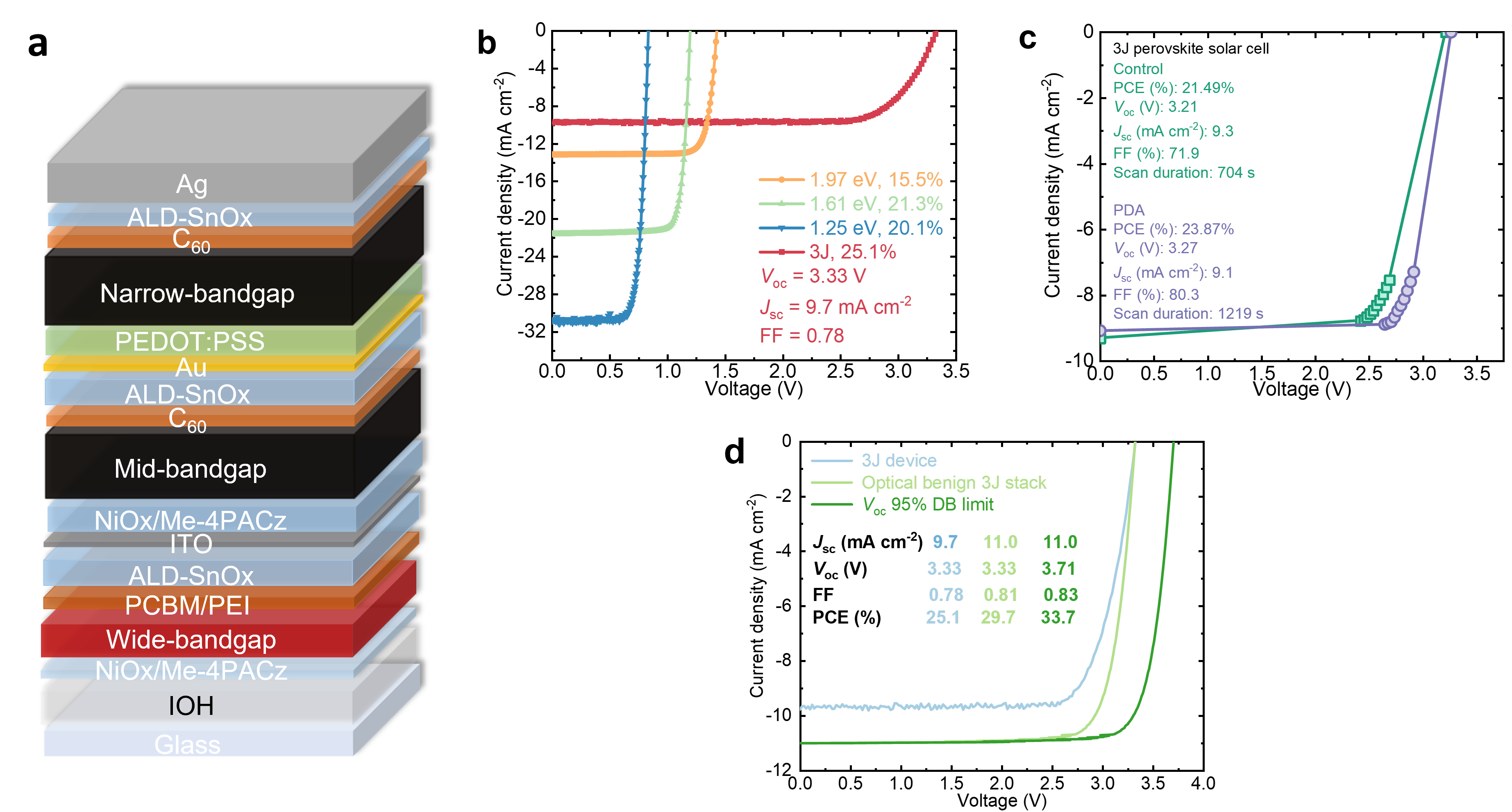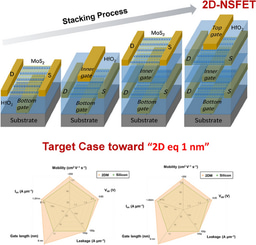All-perovskite triple-junction solar cell achieves 25% power conversion efficiencies and promises to break the theoretical limit
Published in Materials
Among all forms of energy resources, solar power is a pivotal contributor to carbon-neutrality targets worldwide. Using a photovoltaic (PV) cell, solar energy is directly converted into electricity, which can be exported through the power grid or used to power chemical fuel production. Low cost, high efficiency, and long stability are crucial factors in deploying PV technologies at a multi-TW scale. Emerging perovskite semiconductors exhibit advantages such as compatibility with low-cost production, low embodied energy, based on earth-abundant elements, lightweight and flexibility. Recently, the maximum power conversion efficiency (PCE) of single-junction (SJ) perovskite solar cells (PSCs) has reached 26.15%, close to 26.8% of crystalline silicon solar cells.
Integrating multiple absorber layers into a tandem solar cell overcomes energy losses observed in single junction PV cells. Thanks to the recent development of perovskite with bandgap energies from 1.2 to 1.8 eV, double-junction (2J) tandem solar cells based on perovskite-perovskite and perovskite-silicon have achieved certified PCEs of 29% and 33.9%, respectively. All-perovskite triple-junction (3J) solar cells featuring cascaded 2.0, 1.6, and 1.2 eV absorbers have the potential to deliver PCEs beyond those of state-of-art 2J tandems and well beyond the detailed-balance limit for SJs; however, they have yet to achieve their full potential, mainly due to the processing constraint of tandem cells and significant performance loss of 2.0 eV perovskites.
In 2020, we reported a strategy to fabricate reproducible all-perovskite 3J solar cells with low resistivity loss (J. Wang and R.A.J. Janssen et al., Nat. Commun. 11, 5254 (2020)). A proof-of-concept PCE of 16.8% was demonstrated when combining three different perovskite absorber layers produced via a universal two-step solution process. In early 2023, our group developed photostable Rb/Cs mixed-cation inorganic perovskites (Z. Wang and E.H. Sargent et al., Nature 618, 74–79 (2023)). Rb+ lattice doping enabled a 2-eV bandgap with low Br-contents and induced lattice distortion to suppress light-induced halide segregation. As a result, the first certified efficiency (23.3% quasi-steady state) was reported for perovskite-based triple-junction solar cells.
Organic-inorganic hybrid perovskites have advantages over all-inorganic counterparts due to better ambient stability and higher device performance. However, for 2-eV perovskites produced from high Br contents (>60%), prior reports documented significant performance losses attributed to light-induced halide segregation. We find here that, for perovskites having a high Br/I ratio, it is halide heterogeneity in the perovskite bulk – immediately following synthesis – that is the primary performance-limiting factor. Examining the cross-sectional composition of perovskite films found the formation of a more Br-rich phase at the buried perovskite interface (Fig. 1). This corresponds to a high defect density, resulting in non-radiative recombination losses at the heterojunctions of the perovskite/charge transporting layer. The heterogeneity also leads to carrier trapping during device operation and reduces charge-carrier lifetimes, leading to inefficient current extraction.

Figure 1. Compositional profiles and the impact on the optoelectronic properties of Br-rich wide-bandgap perovskites. a, The ratio of atomic concentrations between halide (Br, I, and Cl) and Pb atoms obtained from XPS depth profiles for the control (solid lines) and PDA-added (dashed lines) perovskite films. The vertical line is a guide to show the interface with the HTL. b, QFLS of control and PDA-added perovskite films deposited on glass (neat), with an electron-transporting layer on top (w ETL), and on a hole-transporting layer (w HTL). The perovskite samples are further post-treated with a PDA solution on the top surface. c, The rise (left) and fall (right) time (μs) extracted from transient-photocurrent measurements for the control and PDA-modified PSCs.
We posit that phase heterogeneity is attributed to a fast crystallization process of Br-based perovskite species. We turned therefore to propane-1,3-diammonium iodide (PDA) salt, which has both a templating effect on perovskite growth and a capability to passivate surface defects, as have been previously reported in our group (H. Chen and E.H. Sargent et al., Nature 613, 676–681 (2023)). By studying the dynamic formation of perovskite in situ, we found that PDA-added films exhibit delayed growth of perovskites, allowing more relaxation time for different halide ions to exchange and thereby producing uniform mixed-halide perovskite phases (Fig. 2). This eliminates detrimental interfacial losses in the presence of a charge transporting layer, which retains efficient extraction of funneled charge carriers from the device even when light-induced halide segregation occurs.

Figure 2. Formation kinetics of Br-rich wide-bandgap perovskite films. Time-resolved absorption intensity maps during spin-coating of a, control, and b, 1 mol% PDA-added perovskite precursor solutions. The antisolvent anisole was dropped onto the spinning substrate at ~39 s. c, The absorption spectra of perovskite precursor films after the spin-coating and after 50 s thermal annealing at 100 °C.
We levered these insights to fabricate high-performing 2 eV perovskite absorbers based on a high Br-to-I ratio (0.6:0.4). In an inverted (p-i-n) device structure, we minimized interfacial losses at both HTL and ETL heterojunctions. This enabled a record open-circuit voltage (Voc) of 1.44 V; representing 86% of the detailed-balance limit at a 1.97 eV bandgap (Fig. 3). We reveal that halide homogenization also increases the operating stability of devices beyond that of existing PSCs with ~2 eV bandgap, including their all-inorganic analogs reported in the literature.

Figure 3. Photovoltaic performance of 1.97 eV wide-bandgap PSCs. a, Bandgap-dependent Voc for p-i-n single-junction PSCs with a PCE above 5%. The cell data was acquired from an open-access perovskite database. b, J–V characteristics (reverse scans) of single-junction 1.97 eV PSCs without (control, green) and with 1 mol% PDA addition (purple) in the perovskite bulk. c, Stabilized MPP tracking of encapsulated control and PDA-modified PSCs in the ambient at room temperature under simulated AM1.5G 1-sun illumination conditions.
Deploying the new wide-bandgap perovskite technology within all-perovskite 3J solar cells, we achieved a record Voc of 3.33 V and a PCE of 25.1% (Fig. 4). We document an NREL-certified quasi-steady-state (QSS) PCE of 23.87%; this is the highest certified PCE of an all-perovskite triple junction solar cell. Guided by optical simulation, we have demonstrated a route for all-perovskite 3J devices to surpass state-of-the-art all-perovskite tandem technologies and achieve a PCE beyond the detailed balance limit.
Figure 4. Photovoltaic performance of monolithic all-perovskite triple-junction solar cells. a, Device configuration of optimized 3J cell stack. b, J–V characteristics of the representing 1.97, 1.61 and 1.25 eV and the champion 3J solar cells. c, NREL-certified J–V characteristics of 3J devices using a control (green) and PDA-modified (purple) 1.97 eV sub-cells. d, Experimental and reconstructed J–V characteristics of the 3J device from the simulated EQE at different optical conditions and assuming a Voc of 95% of the detailed-balance limit was achieved in each sub-cell.
For more details, please check out our paper “Halide homogenization for low energy loss in 2-eV-bandgap perovskites and increased efficiency in all-perovskite triple-junction solar cells” in Nature Energy (https://www.nature.com/articles/s41560-023-01406-5).
Follow the Topic
-
Nature Energy

Publishing monthly, this journal is dedicated to exploring all aspects of this on-going discussion, from the generation and storage of energy, to its distribution and management, the needs and demands of the different actors, and the impacts that energy technologies and policies have on societies.
Related Collections
With Collections, you can get published faster and increase your visibility.
Microgrids and Distributed Energy Systems
Publishing Model: Hybrid
Deadline: Mar 31, 2026



Please sign in or register for FREE
If you are a registered user on Research Communities by Springer Nature, please sign in